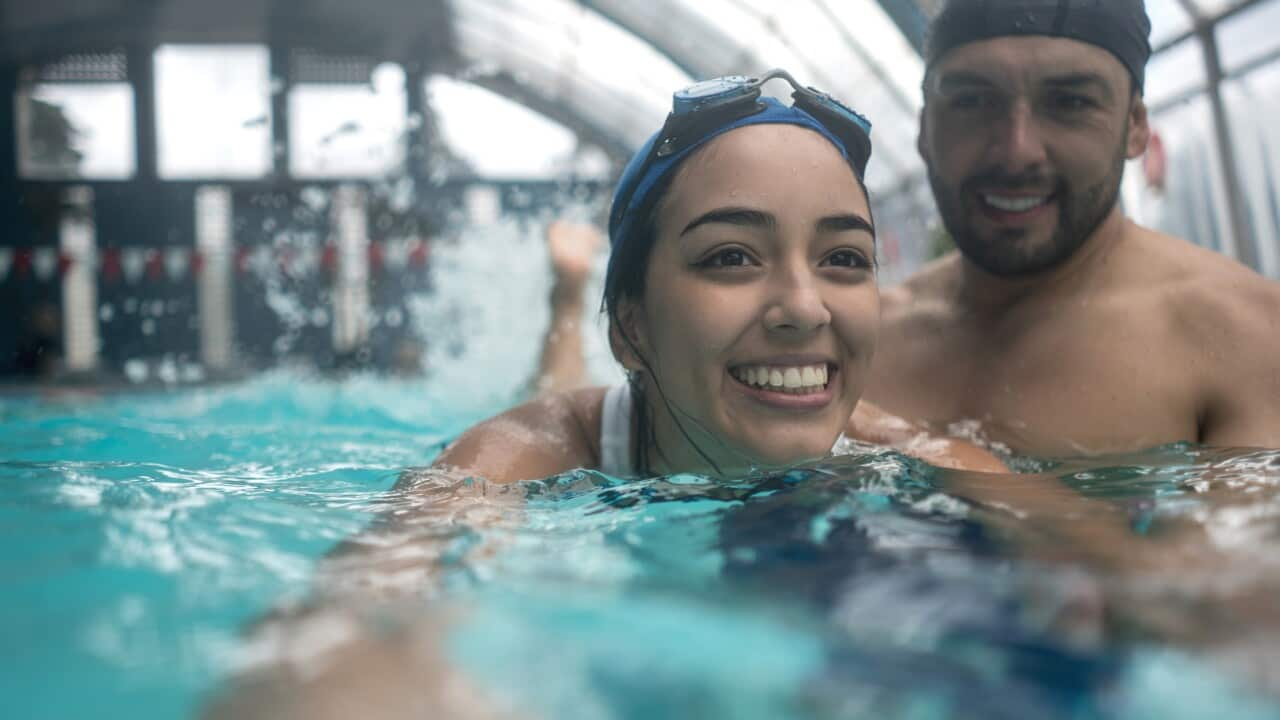英語を理解し話すことは、オーストラリアでの生活を向上させるのにとても役立ちます。ポッドキャスト、SBS Learn Englishでは、日々のさまざまなシチュエーションで使えるとっさの英語や表現を、あらゆる例を取り入れて簡単に説明します。
このエピソードは、中級者に適しています。聴き終わったらクイズで学習成果を確認しましょう。
学習ノート
スイミングを楽しむ際に使用できるさまざまなフレーズ:
- Let’s start in the shallow end.
- Try to do a back float.
- I’m floating!
- I’d like to swim three laps today!
- Let's jump in the deep end.
- Let’s tread water to rest.
- I mainly swim freestyle.
- I usually swim backstroke.
- I want to practise breaststroke.
- I try butterfly sometimes, but it’s really challenging.
口語的な言い回し:
To keep your head above water
直訳すると「頭を水面にキープしている」ですが、「かろうじて持ち堪えている」という意味でも使われます。
To tread water
立ち泳ぎをする
To test the waters
様子を伺う、試す。水に入る前に指や足で水温を確かめる事から転じた言い回しです。
ボキャブラリー:
The shallow end of the pool
プールの浅瀬
A back float
仰向けに浮かぶ
A front float
うつ伏せで浮かぶ
Floating
浮かぶ
The deep end
(プールなどの水位が)深い側
A stroke
(泳ぐ際の)ストローク
Freestyle
フリースタイル、自由形
Backstroke
背泳ぎ
Breaststroke
平泳ぎ
Butterfly
バタフライ
学習のポイント:
今回のダイアログには、命令口調にならないように優しく指示をしたいときに便利な言い回しが幾つか登場しました。
1つ目は「Let's」を使う言い方です。
会話の中でアランさんは泳いでおらず自分自身を含める必要はありませんでしたが、これによって柔らかさが加わるのです
Let’s start in the shallow end.
- Let’s start now!
もう一つは、「try to」を使う言い方です。
この言葉を含ませることによって、学んでいることが簡単ではないというニュアンスが出てより相手に寄り添った言葉となります。
- Try to do a back float.
みなさんも、周りの人たちがどうやって柔らかく指示を出しているか注意して聞いてみましょう!
トランスクリプト:
(注:これは一字一句書き起こしたものではありません)
SBS acknowledges the Traditional Custodians of Country and their connections and continuous care for the skies, lands, and waterways throughout Australia.
You stand outside the pool, watching kids laugh and run past. The bright blue pool looks big and a little scary. You really want to swim, but what if you don’t understand the instructor? You worry that your English isn’t strong enough to follow every word.
I’m Josipa, and my English isn’t perfect—but that’s okay. I’m learning all the time.
‘I can do this’, you tell yourself. Before your first swimming lesson, you’ve practised some key words and phrases to help you feel ready and confident enough to join in.
Your heart beats faster, but excitement wins over fear. Today, you step closer to the water. Today, you know how to listen and how to speak during a swimming lesson.
Now, imagine yourself in the water. Allan is the instructor, teaching Claire how to swim…
Allan
Let’s start in the shallow end. Try to do a back float.
Claire
I’ll try but I'm a bit scared… okay, I think I’m floating!
Allan
Fantastic! OK. Now let's jump in the deep end.
Claire
Done! I’m tired already.
Allan
See...Keep with it… eventually you’ll be swimming freestyle! Now just tread water to rest.
Claire worked hard to keep her head above water in her swimming today. You can also say someone is keeping their head above water when they are managing, even if it’s tough.
There’s even a podcast with the same name — Head Above Water — where comedians and good mates Sashi and Suren dive into what Australians love about water. One of them loves swimming, the other doesn’t even like getting wet!
Now, let’s go through Allan and Claire’s dialogue together, so you can keep your head above water while learning new phrases.
Allan first said,
Let’s start in the shallow end.
The shallow end is the part of the pool where the water is not very deep. If you don’t know how to swim, that’s exactly where you want to be.
He also asked Claire,
Try to do a back float.
Here, Allan is asking Claire to lie on her back in the water and float without sinking.
A back float is when you lie on your back in the water. Your face stays above the water. Your body is relaxed. Your arms and legs are spread out a little so you can stay on the surface. That’s what we call a back float.
You can also do a front float. This is the opposite of a back float. You lie on your stomach in the water. You stretch your arms forward and keep your face in the water while you float. When I do a front float, I hold my breath or blow bubbles to stay relaxed.
Claire then said,
I’ll try but I'm a bit scared… okay, I think I’m floating!
We already heard that floating means staying on the surface of the water without sinking. For example, you can say,
I’m floating on my back.
Here, “floating” is a verb. The word float can also be used as a verb:
I can float without moving my arms or legs.
But when we say a float, it’s a noun. For example:
I did a float for a few seconds.
Next, Allan said,
Fantastic! OK. Now let's jump in the deep end.
The deep end is the part of the pool where you usually can’t touch the bottom. It’s best for people who can swim well. Beginners often start in the shallow end to practise floating, kicking, and swimming before moving to the deep end.
At the end of the dialogue, Allan said,
Keep with it… eventually you’ll be swimming freestyle!
Swimming freestyle?
Freestyle is a swimming style, or we can say stroke.
Actually, the word stroke also means one complete movement of your arms while you’re swimming. We can also use it to talk about different ways of moving in the water, or different styles of swimming, like freestyle.
So, freestyle is a swimming style, or stroke, where you lie on your stomach and move your arms forward one after the other while you kick your legs. It’s the fastest stroke, or swimming style. If that sounds like your style, you could say,
I mainly swim freestyle.
There are many different strokes of swimming. Perhaps you’ve seen them when watching the Olympics?
Have you heard of the backstroke?
I usually swim backstroke.
Or the breaststroke?
I want to practise breaststroke.
There’s also the butterfly stroke,
I try butterfly sometimes, but it’s really challenging.
At the end of our dialogue, Allan also said,
Now just tread water to rest.
To tread water means to stay in one place in the water without sinking. You move your arms in small circles and kick your legs gently to keep floating. When I feel tired in the water, I tread water and take a break.
Now that you’ve learned some key phrases and vocabulary, let’s listen to Allan and Claire’s dialogue one more time. After that, we can test the waters ourselves.
By the way, to test the waters means to slowly and carefully try out something new before fully committing – just like when we think the water in the pool might be very cold, so we test it out with one foot before we jump in.
But you can use this expression in many different situations. For example: Before starting a new hobby, I like to test the waters by watching tutorials online.
Maybe you can test the waters with this useful podcast about Australia's water culture:
SBSの日本語放送は火木金の午後1時からSBS3で生放送!
火木土の夜10時からはおやすみ前にSBS1で再放送が聞けます。










